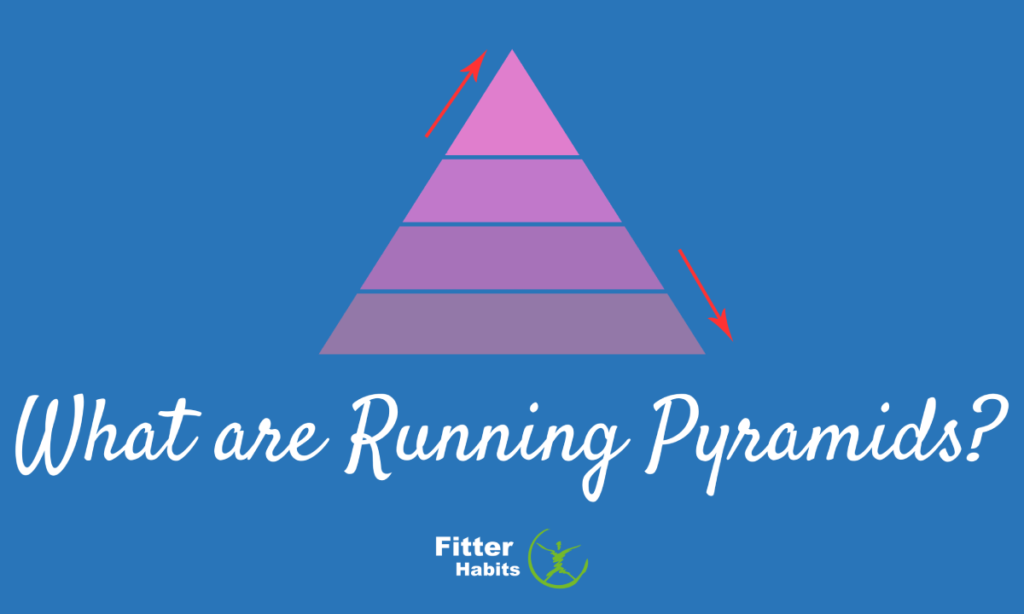Ready to take your running to the next level, interval-training pyramids are the way to go. Let’s explore some different options for running pyramids workouts.
Runners everywhere want to get faster, but it can be hard to know exactly how to get the job done. Some runners who are training for a marathon or half marathon simply try to push harder in their long runs, but that’s not usually the answer. Speed play is a great way to up your cardio fitness and increases your speed — and pyramid workouts are an awesome way to get the job done fast.
Contents
What Is A Pyramid Workout?

Picture a pyramid — broad at the bottom, narrow at the top. Pyramid workouts (also known as ladder workouts), typically start with a lighter effort, push hard to an intense effort, and return a lighter effort near the end of the workout.
The light to intense effort range can involve hitting a certain mile pace, hitting a certain number on your rate of perceived exertion, or spending a longer amount of time pushing hard as the workout progresses.
Examples of pyramid style speed workouts include:
Pyramid workout A: Focus on Pace
Run 1 minute at 5.0 mph, followed by 1 minute at recovery pace
Run 1 minute at 5.5 mph, followed by 1 minute at recovery pace
Run 1 minute at 6.0 mph, followed by 1 minute at recovery pace
Run 1 minute at 6.5 mph, followed by 1 minute at recovery pace
Run 1 minute at 7.0 mph, followed by 1 minute at recovery pace
Run 1 minute at 6.5 mph, followed by 1 minute at recovery pace
Run 1 minute at 6.0 mph, followed by 1 minute at recovery pace
Run 1 minute at 5.5 mph, followed by 1 minute at recovery pace
Run 1 minute at 5.0 mph, followed by 1 minute at recovery pace
Pyramid workout B: Focus on Rate of Perceived Exertion
Run 3 minutes hard, followed by 3 minutes at an easy pace
Run 5 minutes hard, followed by 5 minutes at an easy pace
Run 7 minutes hard, followed by 7 minutes at an easy pace
Run 5 minutes hard, followed by 5 minutes at an easy pace
Run 3 minutes hard, followed by 3 minutes at an easy pace
Pyramid workout C: Focus on Distance
Run 200m hard, followed by 200m at recovery pace
Run 400m hard, followed by 400m at recovery pace
Run 800m hard, followed by 800m at recovery pace
Run 400m hard, followed by 400m at recovery pace
Run 200m hard, followed by 200m at recovery pace
Are Interval Workouts For Everyone?
In addition to cross training and strength training, speed workouts (also known as fartlek workouts — a Swedish term meaning ‘speed play’ — in the running community) help your body experience new aerobic challenges, heart rate variations, and often lead to faster speeds.
During a pyramid session, it’s important that you don’t try to push too hard the entire time. High-intensity bursts of speed are meant to be followed by periods of easy running (or even walking).
Whether you’re training for a short or long distance race, using a track workout or a treadmill workout to focus on your speed can help take you to the next level. If you’re not used to sprinting, these running workouts may feel uncomfortable at first — and that’s the point.
Speed training should not feel easy, and it’s likely that you’ll experience some soreness the following day. Be sure to give yourself some recovery time between interval sessions.
Cool bonus: if you’re focusing on weight loss, speed play can help get you there. Marathon training and half marathon training are fantastic ways to get in shape, but many people find that they don’t experience the weight loss they’d hoped for when focusing solely on long-distance runs. Shorter, faster runs that include interval training create heart rate spikes that can lead to increased, faster weight loss.
Warm-Up And Cool Down: Why They Matter
When you’re running pyramid or reverse pyramid sessions, your body needs some time to ease into the process. An easy mile warm-up and cool down can work wonders in both helping your body prepare for the workout ahead and clearing lactic acid from your system (which will work wonders for shortening your recovery time after a speed workout).
Final Word on Running Pyramids
Pyramid workouts are a fast, simple, and fun way to increase your running speed and your overall cardio health. When you start running pyramids, be sure to take it at your own pace. You may want to try focusing on pyramids that base your speed on the rate of perceived exertion so that you can control your pace.
Remember, there’s nothing wrong with walking between intervals. The goal is to spike your heart rate and then quickly bring it back down, improving your aerobic fitness.
FAQs About Running Pyramids
Can anyone run pyramid sessions?
Absolutely. Choose (or make up) a pyramid workout that makes sense for your ability and the time you have available, and get to work.
Is it ok to walk between intervals?
Definitely! The goal of a pyramid session is to push your body to the limit and then quickly recover — as you begin to grow in your fitness, walking may be a necessary part of allowing your heart rate to recover.



